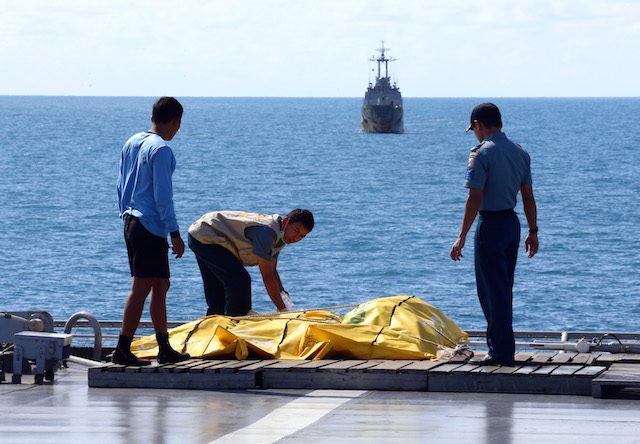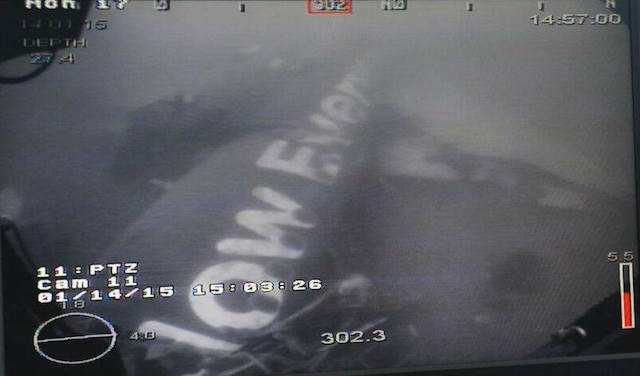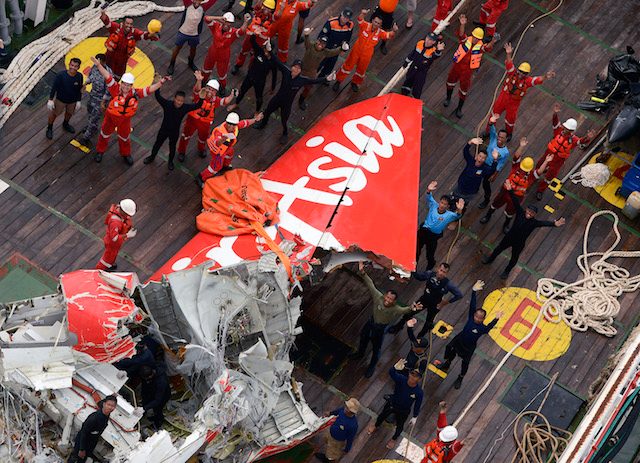SUMMARY
This is AI generated summarization, which may have errors. For context, always refer to the full article.

JAKARTA, Indonesia – The 92 victims still missing after an AirAsia plane crash could have been swept away or be lost on the seabed after no more bodies were found in the jet’s fuselage, Indonesia’s search and rescue agency said Wednesday, January 28,
Flight QZ8501 went down in the Java Sea on December 28 in stormy weather with 162 people on board, during what was supposed to be a short trip from the Indonesian city of Surabaya to Singapore.
So far just 70 bodies have been recovered. Authorities had hoped that the majority of the passengers and crew would be in the plane’s main section, but after several days searching the fuselage, they said no more bodies could be located.
“They could be on the seabed, or have been swept away by waves and currents,” S.B. Supriyadi, a search and rescue agency official who has been coordinating the hunt, told AFP.
The military, which has provided the bulk of personnel and equipment for the operation, withdrew from the search Tuesday due to the failure to find more victims, and after several failed attempts to lift the damaged fuselage. (READ: Indonesian military calls off AirAsia wreckage recovery)

One more week for Basarnas
“We hope search and rescue teams would return to the sea and find the missing victims,” the relative of one victim told MetroTV. “But we appreciate everyone who helped, Basarnas, the military, and especially the volunteers.”
Basarnas is the civilian search and rescue agency, which said it will push on with the hunt for at least a week, with 3 aircraft, several ships, and divers.
While Supriyadi suggested it would be tough to find any more victims, Basarnas chief Bambang Soelistyo said he was “optimistic”.
He added that search and rescue teams were being given two days’ break and would push on with the hunt afterwards.
The agency said that the main aim of the operation is to find more bodies not to lift the plane’s fuselage, which has split in two.
“I am optimistic, because Basarnas personnel are not ordinary people; they’re extraordinary,” said Dwiyanto, the father of one of the victims said, according to MetroTV.

Clues to probe?
However, analysts have reacted with surprise to the suggestion that the rest of the wreckage might be left on the seabed, as retrieving it would help with the investigation into the crash.
The jet’s black boxes – the cockpit voice recorder and flight data recorder – have been recovered, and investigators are analyzing them. A preliminary report into the accident is being completed this week.
Just moments before the plane disappeared off the radar, the pilot had asked to climb to avoid a major storm but was not immediately granted permission due to heavy air traffic. (READ: AirAsia plane climbed at speed ‘beyond normal’ then stalled)
As part of the probe, investigators have been examining maintenance records of a key part of the plane’s automated control systems.
A person familiar with the investigation told Reuters “there appears to be some issue” with the twin Flight Augmentation Computers (FAC). Tempo reported a series of maintenance problems with the computerized rudder system of that particular aircraft in the days and months before the loss of Flight QZ8501.
But even if the FAC failed, that would not have directly caused the crash, experts say, although without them the pilots would have had to rely on manual flying skills that are often stretched during a sudden airborne emergency.
A second person familiar with the probe also told Reuters investigators were also looking at how the pilots dealt with the chain of events leading up to the crash. – with a report from Agence France-Presse/Rappler.com
Add a comment
How does this make you feel?
There are no comments yet. Add your comment to start the conversation.